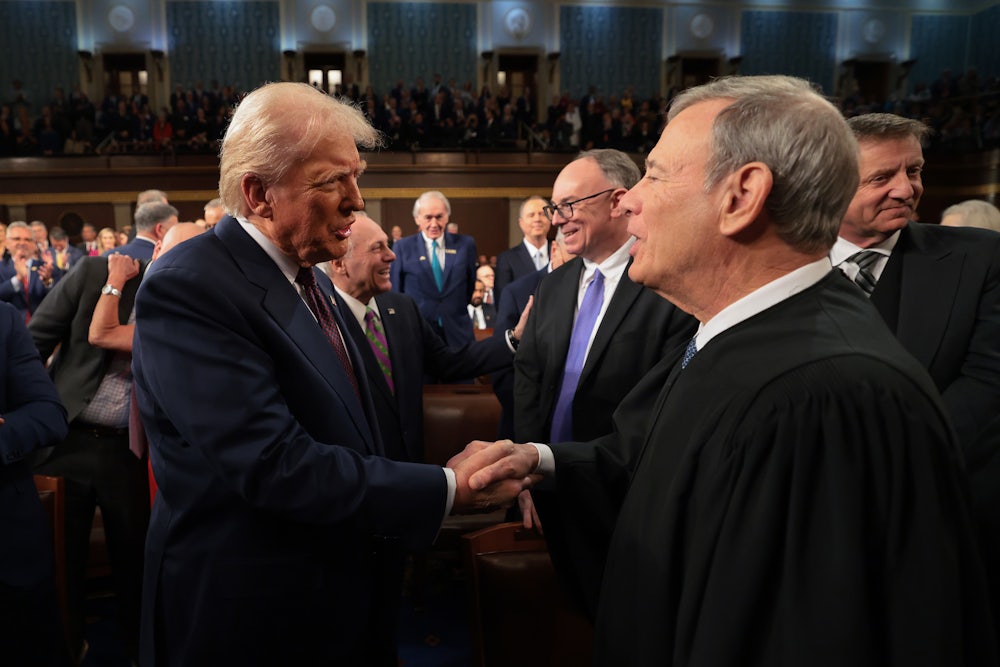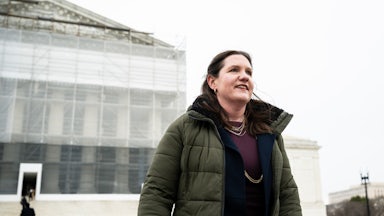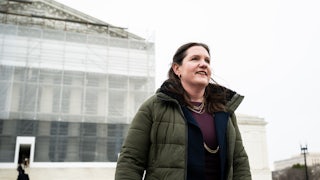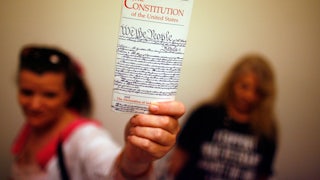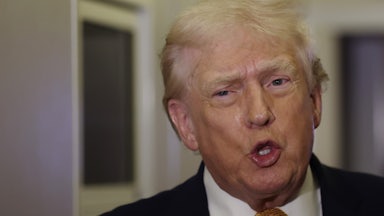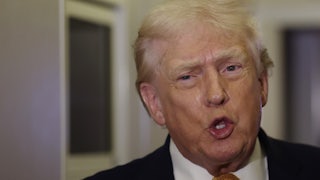Last month, Justices Neil Gorsuch and Brett Kavanaugh denounced what they perceived to be a growing problem: federal judges in the lower courts ignoring the Supreme Court’s decisions in major cases. “Lower court judges may sometimes disagree with this court’s decisions, but they are never free to defy them,” they gravely intoned.
Their target was Judge William Young, a federal judge in Massachusetts appointed by Ronald Reagan in 1985, who allegedly defied the court’s orders in a case involving frozen NIH grants. He had distinguished the case from one involving frozen Department of Education grants earlier this year. In a court session last week, Young apologized for any perceived defiance. Other jurists, including retired Justice Stephen Breyer, have since come to Young’s defense.
If Gorsuch and Kavanaugh are looking for other targets for their ire, there is good news: Another prominent federal judge issued an order on Monday that defied both black-letter federal law and long-standing Supreme Court precedent. They might even be able to identify the culprit on sight since they all work in the same building.
Chief Justice John Roberts stayed a lower court order on Monday that had prevented President Donald Trump from removing Rebecca Slaughter, a commissioner on the Federal Trade Commission, without cause. His administrative stay was done solely through his own authority as a circuit justice—more on that later—and without the input of any other justices.
The move, which effectively suspends Slaughter from office while litigation unfolds, is impossible to square with the last 90 years of Supreme Court decisions, including ones that directly apply to the matter at hand. Roberts did not write to explain his reasoning or why the emergency intervention was justified.
Slaughter is one of the many federal officials removed by the White House since January despite having legal protections against their dismissal. Trump announced his intent to oust Slaughter and another FTC commissioner in March. (The other commissioner has since dropped out of the litigation.)
Her litigation stands apart, however, because she works for the agency for which the Supreme Court first upheld for-cause protections in 1935. Since the FTC’s establishment in 1914, Congress has prohibited presidents from firing FTC commissioners except “for cause,” a term that in this case meant “inefficiency, neglect of duty, or malfeasance in office.”
Slaughter does not stand accused of any wrongdoing. A lawyer by trade who previously worked for New York Senator Chuck Schumer, she was initially appointed to the FTC with Senate approval by none other than Trump himself in 2018 for one of the Democratic seats on the agency. (Federal law also requires a partisan balance of seats on the board.) President Joe Biden renominated her for a second seven-year term in 2023, and the Senate again duly confirmed her.
When Trump claimed to order Slaughter’s dismissal earlier this spring, she filed a lawsuit in federal court in the District of Columbia to challenge her ouster. A federal district court judge issued a temporary restraining order to block her removal, and the D.C. Circuit Court of Appeals upheld it a few months later. The courts cited both federal law and Supreme Court precedent—namely, the landmark 1935 case Humphrey’s Executor v. United States.
In Humphrey’s Executor, the Supreme Court recognized an exception to the president’s general power to fire top-level federal officials at will. When Congress created agencies that wielded “quasi-legislative” or “quasi-judicial” power, the court reasoned, it did not violate the separation of powers for Congress to prohibit presidents from firing the heads of those agencies except for cause.
Humphrey’s Executor provided an important barrier between the day-to-day politics of the White House and the ordinary functions of financial regulators like the FTC, the Securities and Exchange Commission, and, perhaps most importantly, the Federal Reserve Board of Governors. It is not hard to imagine the damage that could be done if presidents could freely set interest rates to suit their electoral needs or adjudicate insider-trading cases on behalf of their campaign donors.
The Supreme Court has substantially narrowed Humphrey’s Executor in recent years, partly because the conservative majority believes in a “unitary executive” that wields unbounded power over federal agencies and partly because of its general hostility toward progressive regulatory efforts. At the same time, the court’s actual rulings in merits cases have declined to overturn Humphrey’s Executor outright and indicated that its holdings, as applied to multimember commissions with “quasi-legislative” or “quasi-judicial” powers, are still good law.
Since Trump’s return to power, things have changed. In recent months, the conservative justices have stayed lower court orders that invoked Humphrey’s Executor to block Trump’s dismissals of other agency commissioners and board members for whom federal law provided for-cause removal protections. These orders did not overturn Humphrey’s Executor outright; instead they argued that the balance of equities was in Trump’s favor on allowing the removals while litigation continues.
All of this gives the impression that Humphrey’s Executor is on death’s doorstep. But there is a big difference, legally speaking, between a precedent that could soon be overturned and a precedent that actually has been overturned. Lower courts and judges are still bound by Humphrey’s Executor until the Supreme Court formally overturns it in a later decision, which it has not yet done. It has not even taken up a case where it could do so.
Federal judges are in the precedent business, not the prophecy business. As a federal district court judge put it in Slaughter’s case, Humphrey’s Executor and the more recent removal-power cases reflected “binding, on-point, and repeatedly preserved Supreme Court precedent.” This is particularly true in Slaughter’s case because she is a member of the Federal Trade Commission—the agency from which the titular William Humphrey was removed in 1934. (Humphrey died shortly thereafter, so his estate sued for back pay for his illegal dismissal, hence the “Executor.”)
After its lower court defeat, the Trump administration filed an emergency motion to ask the Supreme Court to intervene. It tried to distinguish the case from Humphrey’s Executor by claiming that the FTC had been substantially changed by Congress since 1935 and now wielded “considerable executive power,” a threshold that the court first drew in the 2021 decision Collins v. Yellen. That argument did not persuade lower courts, which considered themselves bound by Humphrey’s Executor.
Why and how did Roberts get involved? His role is esoteric but significant. The Supreme Court’s shadow docket is technically known as its emergency docket, where it hears particularly urgent motions in cases that are still working their way through the lower courts. Until the last decade or so, it was best known for handling last-minute appeals from death-row prisoners who were about to be executed or other death penalty–related litigation.
For logistical convenience, each federal circuit court of appeals is assigned to a specific justice. Some get multiple circuits, and the chief justice always gets the D.C. Circuit Court of Appeals, This allows litigants to direct their motions to that specific justice rather than assemble all nine members every time. The justice in question is referred to as a “circuit justice” in this capacity, evoking the long-bygone practice where Supreme Court justices would “ride circuit” and hear appeals across the country on horseback.
In this capacity, Roberts is effectively operating as a lower court judge in the sense that his decisions can still be reviewed by a higher court, albeit one on which he serves. When a circuit justice receives a motion, they have two options. They can resolve it themselves in their individual capacity (by issuing an emergency stay or declining to do so outright), or they can refer it to the entire court for their collective judgment.
As a matter of course, anything even slightly more than controversial or debatable is referred to the entire court for consideration. The circuit justice can impose an “administrative stay” on their own, but this was historically not seen as a decision in either direction—it was simply a brief pause until the other eight justices could get on the phone. (You can imagine how important this would be when, say, someone was about to be executed.)
For a circuit justice to issue an administrative stay on their own authority means that they think the decision to do so is uncontroversial and unremarkable. Allowing Trump to remove a lawfully appointed and lawfully insulated FTC commissioner, even for a moment, is anything but that. With a single stroke, Roberts effectively overturned a Supreme Court ruling in a directly applicable case and did so without a single word of explanation. Further proceedings will take place next week when the full court considers whether to take up the case outright.
Roberts’s course of action is particularly dismaying because he once realized the dangers of undermining the court and disregarding the value of precedent. He once denounced Texas’s abortion-bounty law for trying to “nullify this court’s rulings” before Roe was overturned, then called for “judicial restraint” and preserving stare decisis when Dobbs was decided. How things have changed. Gorsuch and Kavanaugh were right, after all: There are judges in this country who defy the Supreme Court’s rulings and diminish the high court’s authority. Unfortunately, they also happen to work there.
